 Rumors have been floating around for months that the Seattle Times would shut down, so employees at rival Post-Intelligencer were understandably shocked when a local TV station reported a single-sourced story yesterday that the paper is being put up for sale and would be shut down if no buyer is found. No one, from the P-I‘s publisher on down, is confirming the report or even knowledge of the rumor. This doesn’t stop the Seattle Times from quoting numerous staff and local officials commenting about how sucky a shutdown would be, some of them speaking in the present tense. “I think it’s a horrible tragedy,” said Seattle City Councilman Nick Licata, referring to a single-sourced story that no one has confirmed.
Rumors have been floating around for months that the Seattle Times would shut down, so employees at rival Post-Intelligencer were understandably shocked when a local TV station reported a single-sourced story yesterday that the paper is being put up for sale and would be shut down if no buyer is found. No one, from the P-I‘s publisher on down, is confirming the report or even knowledge of the rumor. This doesn’t stop the Seattle Times from quoting numerous staff and local officials commenting about how sucky a shutdown would be, some of them speaking in the present tense. “I think it’s a horrible tragedy,” said Seattle City Councilman Nick Licata, referring to a single-sourced story that no one has confirmed.
Speculation is focusing on a change of management at P-I owner Hearst Newspapers. Incoming President Steve Swartz reportedly sent employees a memo outlining “100 Days of Change” beginning in early 2009, but offered few specifics. Under the joint operating agreement, either of Seattle’s two daily newspapers must be offered for sale for 30 days before being shut down. The report comes as a particular surprise because well-reported financial troubles at the Seattle Times have had most locals thinking it would be that paper going down first. Keep in mind, however, that this is still a single report based on a single source at a single local TV station. The fact that the publisher of is the P-I‘s main rival denies awareness of it should be taken seriously.
A Benevolent History
Jack Shafer’s account in Slate of how newspapers innovated – and then failed – on the Web is a sympathetic story about an industry that’s often criticized for insularity. In contrast to the popular image that newspaper executives were clueless about online competition, Shafer declares that they were actually paranoid about it. In fact, newspapers threw away a lot of money trying to create early online business models.
The Washington Post had constructed its own interactive service by 1994 and nearly every major newspaper was online by 1999. “Newspapers deserve bragging rights for having homesteaded the Web long before most government agencies and major corporations knew what a URL was,” Shafer writes. In earlier years, Knight-Ridder sank $50 million in an Internet precursor called videotex and newspapers had experimented with fax and even audio editions in the early 1980s.
The problem wasn’t innovation, Shafer notes; it was attitude. Newspaper companies’ approach to these disruptive technologies was first defensive and then opportunistic. Once executives were satisfied that their revenue base wasn’t going away they sought to use new media to find new revenue streams as long as it didn’t mess with the model. Commenting on videotex, he writes, “Once [newspaper companies] they determined that nobody could make money from videotex and the technology posed no threat to the newsprint model, they were happy to shutter their ventures.
But that’s the problem. New technologies never succeed when their use is restricted like that. Shafer calls these “nongenerative” services, meaning that no third party industry can innovate on their platforms. AOL is an example of this. Nongenerative services almost always lose out to “generative” media like the Internet because customers can add their own value. That’s basically why the personal computer has 90% market share and the Mac has 10%. Intel CEO Andy Grove titled his book Only the Paranoid Survive. The newspaper industry had the requisite paranoia, but it didn’t have the innovative attitude to match.
Miscellany
Residents of the New Mexican cities of Santa Rosa, Tucumcari, Clovis, Portales, Lovington and a couple of dozen other cities and towns that currently get home delivery of the Albuquerque Journal will have to find something else to read. New Mexico’s largest daily newspaper, plans to stop home deliveries and rack sales in more than 30 communities around the state. This despite the fact that the Journal lost its only competitor, the Albuquerque Tribune, nearly a year ago. The cost of delivery was just too steep, the publisher said. Elsewhere in New Mexico, Freedom New Mexico stopped home deliveries of the Quay County Sun last week.
The Newark Star-Ledger‘s Paul Mulshine contributes an op-ed piece to The Wall Street Journal that reads at first blush like another curse-the-darkness ranting by an aging journo about the unfairness of it all, but that ultimately makes a persuasive case that no blogger in his of her right mind is going to be caught dead covering city council meetings for free.
McClatchy Watch notes a case of online cluelessness by company management. Responding to rumors that McClatchy was closing its Washington bureau, CEO Gary Pruitt sent off a memo to employees scolding them for spreading the rumor without checking with company management. Of course, it’s management’s responsibility to head off rumors quickly, not employees’ responsibility to verify them. If McClatchy had its internal communications act together, there wouldn’t be an audience for a McClatchy Watch.
Layoff Log
- The drip, drip, drip of layoffs continues at the St. Louis Post-Dispatch: another 39 people have lost their jobs, including 14 in the newswroom. The AP story reckons total announced cutbacks at the P-D amount to 270 in the last 16 months. (Via PaidContent.org)
- The Winnipeg Free Press is begging employees to accept a buyout in order to avoid laying people off next week. The publisher seeks to reduce headcount by about 5%.
- The Buffalo News is offering buyouts to about 300 workers. There’s no word on how many jobs the paper is seeking to eliminate. A similar offer went out last August to 107 employees, but only about a dozen accepted.
- Dow Jones is freezing salaries for a year, reports MediaBistro. Unlike most media companies, Dow Jones has so far managed to avoid major layoffs.
- NJN Publishing, which produces four weekly newspapers in New Jersey, laid off 25 full- and part-time employees, or about 17% of its staff.
And finally
 In a print market that’s hemorrhaging, The Slammer is one newspaper that’s flourishing. Its “newsstand profit margin is four times that of most local dailies, and its circulation has grown to 29,000 – up nearly 50 percent from 20,000 just last year. At more than 500 convenience stores across North Carolina, it’s selling at a buck a pop,” writes The Christian Science Monitor. The secret: The Slammer is full of mug shots, crime reports and allegations of misdeeds. “The men and women, with their dour mugs, bloodied noses, and booze-induced grins, have been arrested for everything from skipping a court date to robbing a food mart. It is, in essence, the local police blotter writ large,” the Monitor writes.
In a print market that’s hemorrhaging, The Slammer is one newspaper that’s flourishing. Its “newsstand profit margin is four times that of most local dailies, and its circulation has grown to 29,000 – up nearly 50 percent from 20,000 just last year. At more than 500 convenience stores across North Carolina, it’s selling at a buck a pop,” writes The Christian Science Monitor. The secret: The Slammer is full of mug shots, crime reports and allegations of misdeeds. “The men and women, with their dour mugs, bloodied noses, and booze-induced grins, have been arrested for everything from skipping a court date to robbing a food mart. It is, in essence, the local police blotter writ large,” the Monitor writes.
Journalism ethicists bemoan The Slammer‘s perverse appeal, but the genre is spreading. Two papers with a similar format have sprung up in Florida and The Slammer is planning to expand its North Carolina distribution.
The secret isn’t just the mug shots and wrongdoings. It’s also the snarky style the paper uses. It sometimes mocks repeat offenders and hosts weekly features like the worst late-night arrest hairdos. Such public flogging is a “step up from the stocks,” says one critic. But victims don’t seem to mind too much. In fact, “the chief complaints the weekly paper gets come from perps complaining that their photos didn’t get printed,” the Monitor writes.

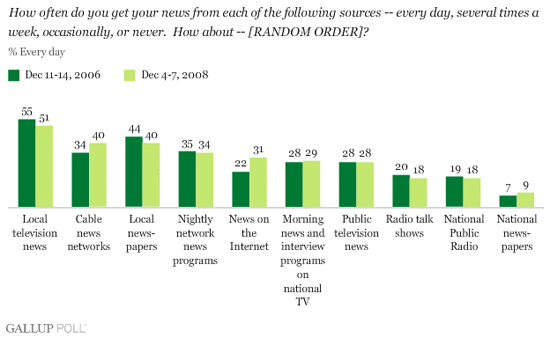

 Richard Pachter says the new book, The Man Who Owns the News: Inside the Secret World of Rupert Murdoch,
Richard Pachter says the new book, The Man Who Owns the News: Inside the Secret World of Rupert Murdoch, 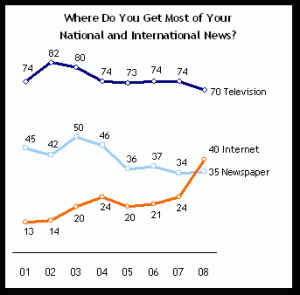 Last month we told you about new Gallup research that showed
Last month we told you about new Gallup research that showed 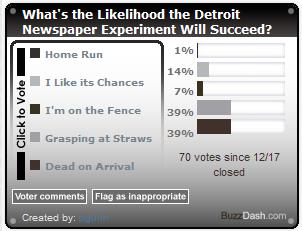
 “Today is set aside as
“Today is set aside as  “Victimhood is an irresponsible abdication of responsibility, a surrender.”
“Victimhood is an irresponsible abdication of responsibility, a surrender.”

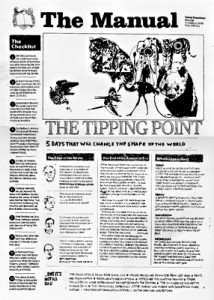 A team of enterprising publishers in the UK produced a four-page
A team of enterprising publishers in the UK produced a four-page 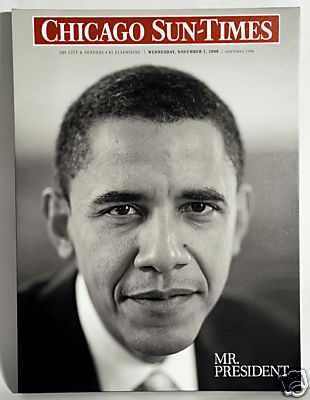 The Chicago Sun-Times
The Chicago Sun-Times 

 The Onion offered a tutorial in how to write a provocative magazine cover line (right).
The Onion offered a tutorial in how to write a provocative magazine cover line (right). The Simpsons showed its snotty character Nelson insulting a journalist. “Hah hah! Your medium is dying!”
The Simpsons showed its snotty character Nelson insulting a journalist. “Hah hah! Your medium is dying!”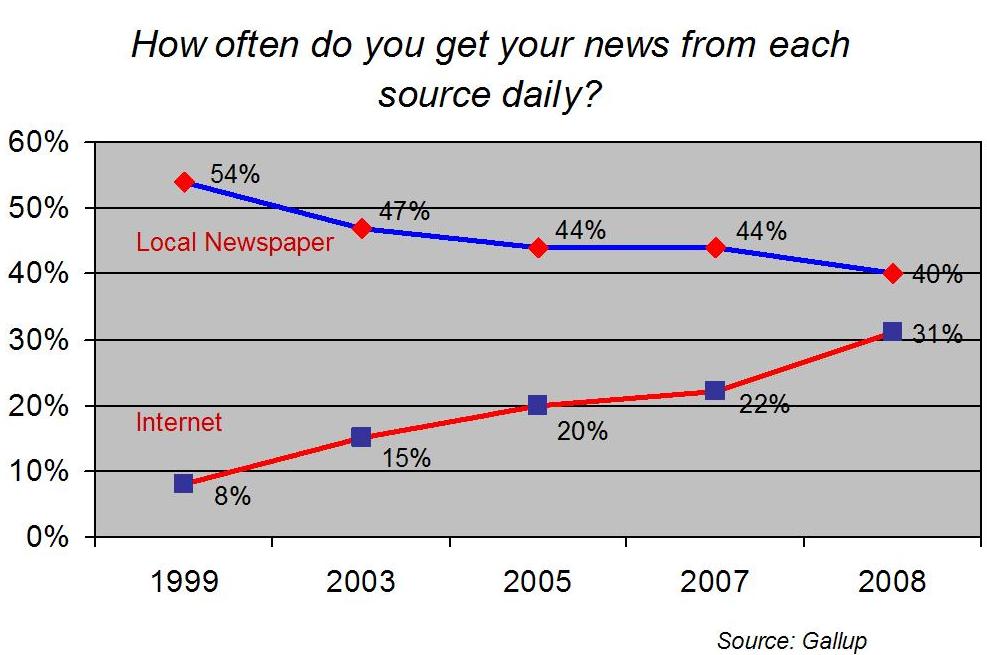


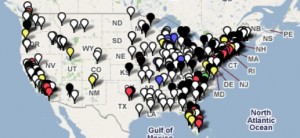

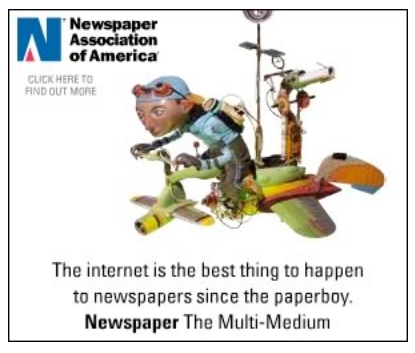
 And Advertising Age
And Advertising Age  Editors at the Wine Spectator
Editors at the Wine Spectator 



